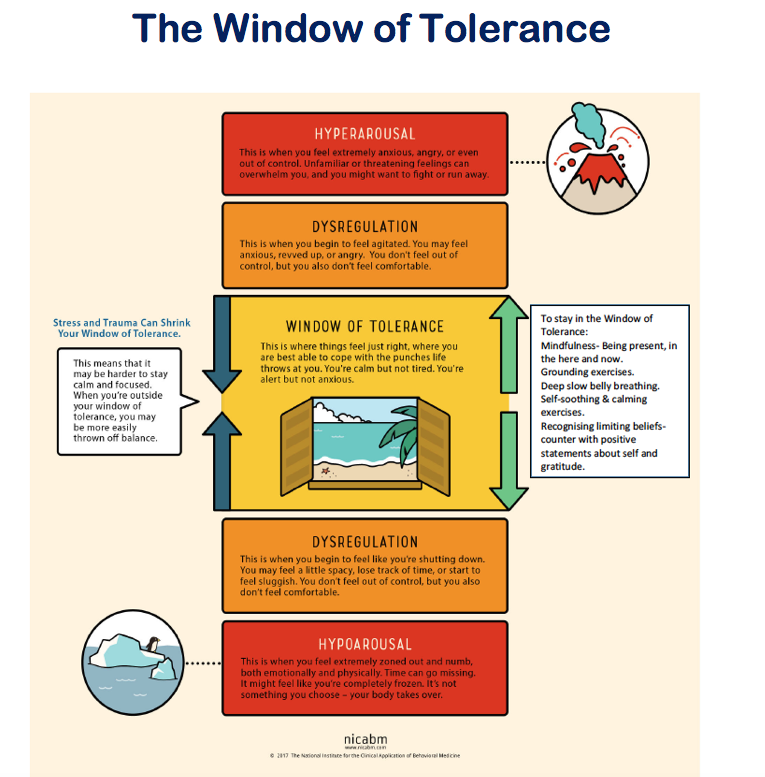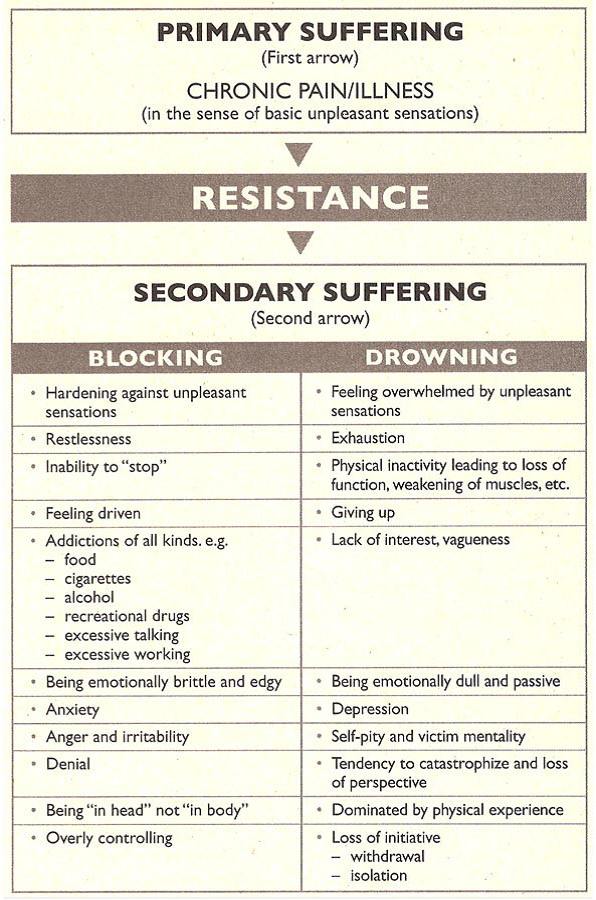Wise Online - View Week
Week 5- Overcoming Difficult Sensations (Pain, Anxiety & Illness)
WISE Recap
- Feel it to heal it.
- Pain and anxiety are often signals asking for attention. Paying mindful curiosity to physical sensations in our body can help them to move through quicker and more effectively.
- Pain is inevitable (first arrow), suffering is optional (second arrow).
- During times of difficulty how the mind has a tendency to escalate our distress. Ask yourself, what is my story line here? Am I still dealing with the first arrow? Try not to shoot the second arrow. Notice your reaction to the first arrow.
- The Window of Tolerance is a place where things feel right. We feel calm, not tired, alert, not anxious). It is VERY NORMAL to come outside our window.
- Use the Window of Tolerance tool to notice when you (or others) are experiencing hyperarousal (stress, anxiety, panic, hypervigilance etc) or hypoarousal (depression, low energy, fatigue, zoned out, burnout etc).
- Self-Compassion is crucial for helping you get back in your window. Be kind to yourself. Honour your feelings. Remember you are doing a great job. You are doing the best you can and that is always enough. Sometimes it takes a little while to get back in your window, sometimes we need some professional help to get back in there. But remember the sun will come out again and you WILL get there.
- Instead of “what if”, replace with “what is”. Open up to the present moment and your body (even if it feels difficult). This will help you with acceptance and will help your mind become free of the mental struggle (suffering).
- Notice your relationship to the unpleasant. Change your relationship to the unpleasant. If it is illness (e.g. anxiety or mental illness there can be an extra layer of thoughts or emotions such as shame or embarrassment). Kindness and self-compassion is essential here.
- Bringing mindful awareness to our pain can help us to not be overly consumed by it and may also help to lessen the production of stress hormones (namely cortisol) in our body.
- Stay with the first arrow. In relation to pain use mindfulness to get curious about the pain. Notice its texture, its colour (if it had one), temperature, pulsing, sharp/dull etc. Breathe into the pain. Breathe around the pain. If the pain moves stay with it. Follow it.
The Window of Tolerance
The Window of Tolerance charts the relationship between stress/ anxiety (hyperarousal, hypervigilance) and hypoarousal (low motivation, depression, dissociation). We ideally want to be in the yellow zone- the ‘creative calm’ zone. When we are in this stage we feel calm, we have a lot of energy, we are not tired, we feel like exercising, we are not sick, and we don’t have unexplained/uncontrolled emotion. It is a place where things feel right. We are calm, but not tired. Alert but not anxious.
The practices in this course are designed to help you recognise when you are outside your Window of Tolerance and help you return to the yellow zone quicker. When practiced regularly, mindfulness will help to expand your Window of Tolerance, so you are less likely to spend time dysregulated.
Dealing with Unpleasant Sensations
We normally react to pain or difficult sensations in one of two ways:
Blocking/ Avoidance: We try to block or deny the discomfort by pushing through it through force of will, by distracting ourselves, or by self-medicating with food, alcohol or drugs. As soon as you stop “pushing through” or your distraction/medication wears off, it can come back even stronger. In cases where the discomfort is a signal indicating corrective action needs to take place, missing the signal can result in injury or disease. In addition to this, self-medicating can create many problems, including complex side-effects or even addiction.
Drowning: We become overwhelmed by it, drowning in the discomfort and its associated fears, judgments and blaming (“I can’t stand this!”, “What if this continues or gets worse?”, “How could I have been so stupid?!?” etc.). This leads to a sense of hopelessness and powerlessness.
Dealing with Suffering More Skilfully
Neither of the above two strategies are very effective or satisfying and a continual reliance on them usually makes things worse than they already are. There is a middle ground, a place where you are neither pushing away difficult feelings/situations, nor being consumed by them. This “middle way” involves learning to feel the sensations or emotions, but not being swept away by them.
Reacting with avoidance keeps us in reactivity, as we keep interpreting our sensations as threats.
By simply practicing acceptance and bringing a level of curiosity to our sensations, we are interrupting the production of stress hormones-which in itself can help reduce the discomfort or pain. A surprising and counter-intuitive result of staying with something in this way is that the discomfort often lessens, or sometimes can even disappear.
You can break the Stress Reaction Cycle (SRC) by bringing awareness to what is happening in the mind and the body (sensations, emotions and thoughts) WITHOUT reacting to it.
We have learnt in the program so far that thoughts create (and fuel) emotions and can evoke strong physical sensations in the body. In order to ensure we are not escalating our distress by overthinking or ruminating negatively about the first arrow, we should become very curious about our thoughts. It may help to journal them or write them down on paper. Then make a decision to consciously let go of them. (My favourite technique is to imagine I am placing those thoughts onto the surface of a leaf and I watch them float away).
Overcoming Anxiety
Anxiety is an uncomfortable, unpleasant feeling usually in the upper torso related to a sense of impending fear or doom. Sometimes it is very clear why we are experiencing anxiety or anxiousness. Other times we cannot pin-point the reason why we are feeling this way.
As well as a cognitive and behavioural component there can be many physical sensations in the body that accompany anxiety. Here is a diagram that illustrates this:

Stress & Anxiety is produced by the Amygdala which is overacting to perceived threat. It is our job to let AmyG know we are okay and that we are safe- that there is no life threatening danger here. We can do this through sensory activation, welcome the sensations onto your body, awareness of breathing (feeling the breath in the belly) and using a mantra such as “this too shall pass” or “I am safe, I am okay”.
Try the following ABCD for overcoming anxiety next time it arises.
A- Acknowledge the Amygdala
Acknowledge the role of the amygdala. “Thank you AmyG, I see you. But I am safe, I am okay”.
B- Breathe & Body
Breathe and welcome the sensations onto your body. Allow the belly to rise and fall. Follow the air moving into the abdomen, stay connected to the sensations of breath. You may like to try 5,5,8 here, belly breathing or box breathing.
C- Compassion
Take the time to offer yourself self-compassion. Be kind to yourself. It is okay to feel this way. It will pass. “It is okay to not want this”. “Let me open to it”. “It is okay to not be okay.” “This too shall pass”.
D- Detach
Be mindful of thoughts about the anxiety itself. You are not your anxiety. Put words to your feelings. Name it to tame it. For example “I notice fear is here”. “I notice Anger arising, I notice worry arising”. Remember why anxiety feels the way it does.
WEEKLY PRACTICE TASKS
INFORMAL PRACTICE- Second Arrow of Suffering
This week, when you have a strong response of anxiety, pain, annoyance or difficulty use second arrow tool to help move through that discomfort. You may even like to ask yourself… what is my story line here? Am I still dealing with the first arrow, or have I well and truly moved into the second one? This practice helps us to recognise when our mind has escalated our distress. Remember- pain is inevitable, suffering is optional.
FORMAL PRACTICE- Regulating Practices
This week there is an opportunity to practice Regulating Practices. These practices are designed for moments of overwhelm, out of control, anxiousness or stress. They are designed help you return to your Window of Tolerance- a place where things feel calm, easy, balanced and where things feel just right.
As best you can try not to judge any sensations or unpleasant feelings/ emotions that arise. Try to bring a level of curiosity to each moment as it unfolds. If you notice your mind wandering remember that is a normal habit of the mind. Just come back to the felt sense of the breath in the body. It may be good to notice where the mind goes to when it wanders away.
Week 5- Regulating Practices Recording (5 min)






